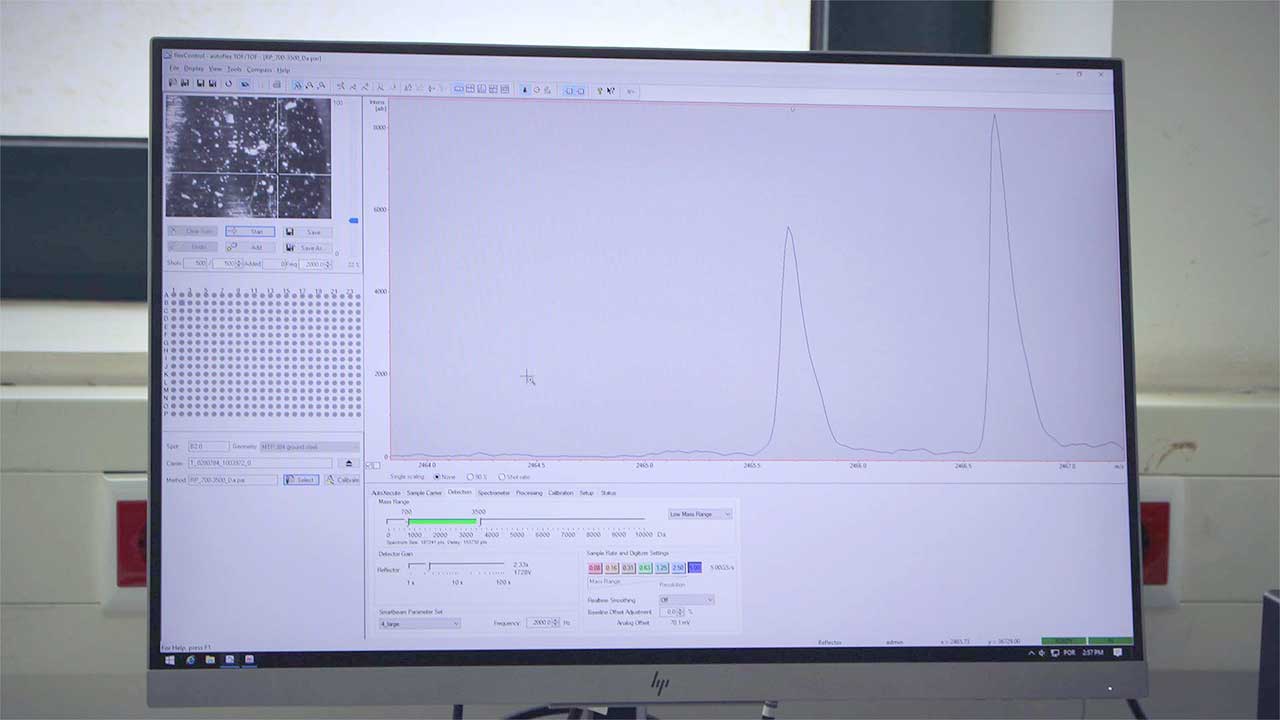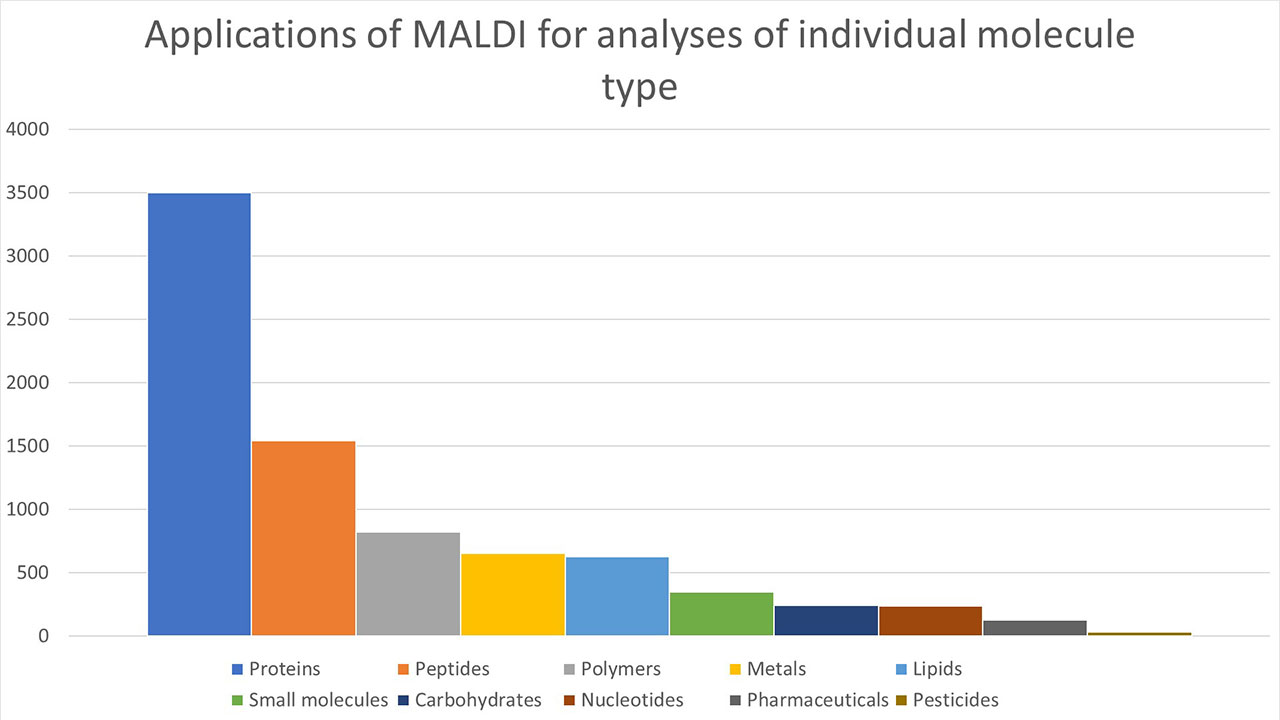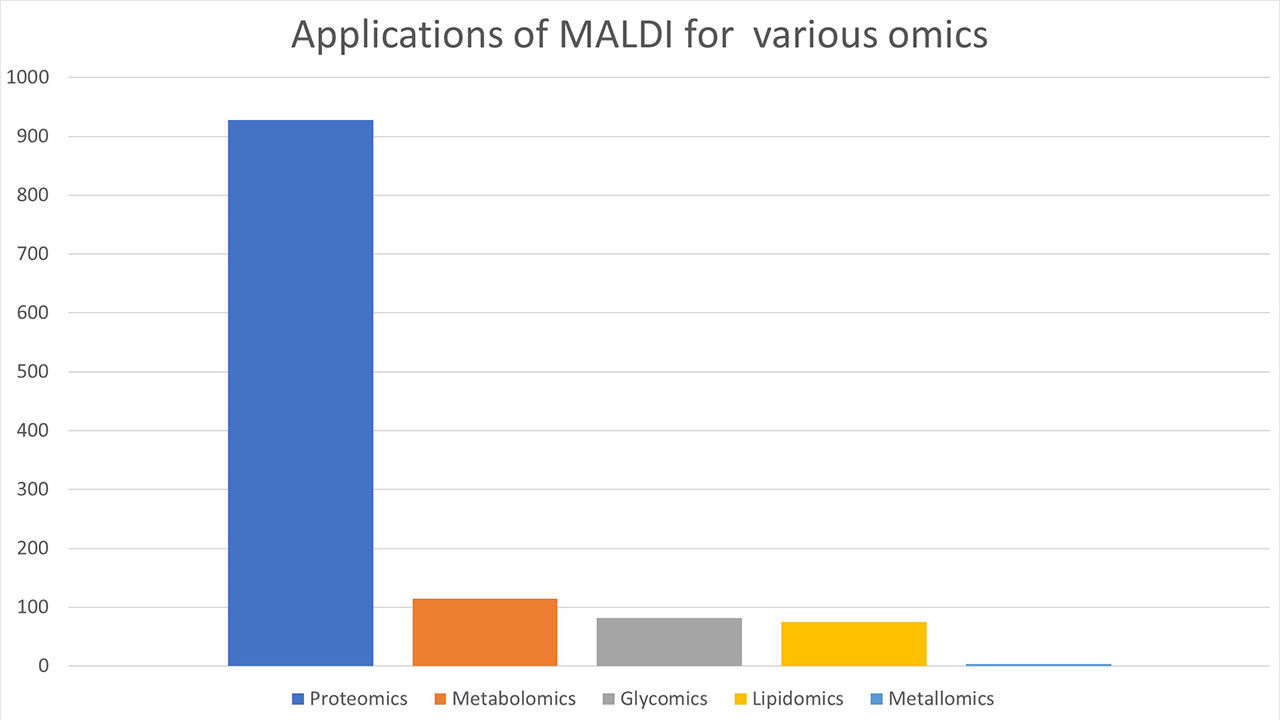
MALDI TOF/TOF Mass spectrometry
The MALDI TOF/TOF MS (Bruker Autoflex maX) equipment installed in CQM, is the first of its kind in the Autonomous Region of Madeira, Portugal. It was acquired with European funds from Programa Madeira 14-20 (PROEQUIPRAM - Reforço do Investimento em Equipamentos e Infraestruturas Científicas na RAM). This equipment is intented for CQM research activities, namely for the molecular mass determination, an also introducing MALDI MS Imaging, searching for the “universal matrix”, involving nanotechnology in MALDI methodology and development of approaches for quantification of molecules. In addition, and depending on the availability of time, the MALDI TOF/TOF MS equipment is open to external services (other public or private institutions).
SUBMIT SAMPLE HERE (for CQM members only)
MALDI TOF/TOF MS equipment
Equipment: Bruker Autoflex maX Matrix-Assisted Laser Desorption and Ionization (Time-of-Flight) 2 Mass Spectrometer
The Bruker Autoflex maX MALDI TOF/TOF MS is a floor standing equipment with proprietary smartbeam-II™ laser technology with up to 2 kHz repetition rate, high dymanic range FlashDetector™ system in conjuction with a 10 bit 5 Gs/s digitizer and PAN™ wide mass range focusing for unrivaled resolution power and mass accurancy.
Project reference: M1420-01-0145-FEDER-000008
Project Manager: João Rodrigues (PI)
Unit Manager: Rosa Perestrelo (PhD)
Autorised User: Rosa Perestrelo (PhD)
Type of equipament: A – Big equipment
Total investment with taxes: € 403 820.00
CQM acknowledges for the financial support of Programa Madeira 14-20 (PROEQUIPRAM (M1420-01-0145-FEDER-000008) - Reforço do Investimento em Equipamentos e Infraestruturas Científicas na RAM ).

MALDI TOF/TOF Mass spectrometry technique
MALDI TOF TOF MS acronym stands for Matrix-Assisted Laser Desorption and Ionization (Time-of-Flight)2 Mass Spectrometry, describing the ionization technique and the type of mass analyzer. The discovery of MALDI ionization in 80´s, independently by two research groups, Tanaka in Japan and joint efforts of Hillenkamp and Karas in Germany, enabled the detection of volatile compounds and high mass biomolecules. It is still a controversy about the who deserved the Nobel prize for MALDI discovery, but the work of both teams was a breakthrough in the field of analyses of biomolecules, particularçy for proteins.
Nowadays, MALDI is still mostly applied for protein analyses, but the number and variety of MALDI applications is expanding (Fig. 1. and Fig. 2.)
Figure 1. Number of applications of MALDI for analyses of individual type of molecules. Source: Web of knowledge database, 19.02.2019.
Figure 2. Number of applications of MALDI for various omics. MALDI is still sought as inevitable source for various omics. Source: Web of knowledge database, 19.02.2019.
Ionization
MALDI technology uses laser light (UV and/or IR) for ionization and desorption of molecules. “Matrix” is usually an organic aromatic compound, which absorbs the laser energy and transfers it to the analyte, thus minimizing the fragmentation caused by a direct laser hit. Therefore, MALDI is considered a “soft” ionization technique, since the extent of fragmentation of molecules and ions is rather low and some important structural information are preserved. Of course, one can induce fragmentation if more structural information is needed!
Sample variety
There are very few methods, which can be compared to this technology in terms of variety and properties of samples, that can be analyzed. Almost all samples can be analyzed with MALDI, starting with inorganic molecules (low mass), polymers, to high molecular weight proteins and their complexes (in the range of several hundred thousand kDa!), from non polar to highly polar samples, soluble, as well as non soluble, and also samples with high ionization potential.
No derivatization of sample is required. It is simply required to mix the analyte with the matrix or substrate, leave it to co-crystallize or facilitate their crystallization and in a few seconds, you can acquire the spectra!
For most applications, previous separation and purification of samples is also not a pre-requisite for measurements.
The only requirement is that the sample is stable in high vacuum conditions.
Sensitivity of detection
Due to its sensitivity, which reaches femtomolar range and small volume of sample required-one can apply 0.2 µL of sample-MALDI is very convenient for samples of biological origin.
MALDI is tolerant against the presence of inorganic salts, and for most applications, there is no need to remove them from the sample.

Routine applications
- Peptides
- Lipids/phospholipids
- Transition metal complexes
- Vitamins (E, C, A, D)
- Natural products, e.g. flavonoids
- Biotyping (identification of microorganisms)
- Oligocarbohydrates
- Poymers (PEG, PAMAM, and others)
- Isotopic distribution of transition metals and their compounds and complexes
Specifications:
MALDI-ion source
- MALDI ion source with integrated self-cleaning procedure
- Laser type: BRUKER smartbeam™-II laser, 355 nm wavelength (3,5 billion laser shots, 2 kHz repetition rate, ≥ 100 μJ/pulse laser energy)
- Ion acceleration: up to +20/-20 kV
- Highly sensitive MALDI Source, with microtiter plate formatted targets
- Automated ion optics cleaning based on laser irradiation
- 2nd generation proprietary PAN™ pulsed ion extraction for high mass accuracy and unmatched resolution spectra across an extended mass range
- 2 kHz Bruker smartbeam-II™ laser focus diameters for versatile applications with different sample preparation techniques
- Target Kit-II with two target frames, MTP384 target plate ground steel, MTP384 target plate polished steel, MTP target plate AnchorChip™384
- Automatically operated sample inlet system
- High resolution magnifying target observation optics with integrated display in Compass™ acquisition software
Linear TOF
- Integrated pumping system with vacuum measurement and control unit: one 300 l/sec
- Turbomolecular pump including oil-free diaphragm-pump
- FlashDetector™ providing unmatched mass resolution and mass accuracy
- TOF-Analyzer for both positive and negative ion mode
- Effective flight path: 120 cm
- Maximum usable laser speed: 2 kHz
- Mass resolution (protein): ≥ 1,100 Cytochrome C (m/z 12,361) FWHM
- Mass resolution (broad range): ≥ 700 for insulin (m/z 5,734), ≥ 900 for Myoglobin M2+ (m/z 12,361), ≥ 1000 for cytochrome C (m/z 12,361), ≥ 1000 Myoglobin (m/z 16,952) FWHM
- MS sensitivity: 500 fmol BSA (m/z 66,000 at S/N ≥ 100:1 shown on Bruker AnchorChip™ target with 1,000 laser shots)
- Mass accuracy (protein mixture): with external calibrant (better than 100 ppm) and with internal calibrant (better than 90 ppm).
Reflector TOF
- Effective flight path: 215 cm
- Maximum usable laser speed: 2 kHz
- Mass resolution: ≥ 26,000 Somatostatin (m/z 3,147.47) FWHM
- Mass resolution (broad range): ≥ 10,000 for Bradykininin 2-9 (m/z 904), ≥ 14,000 for ACTH 1-17 (m/z 2093), ≥ 18,000 for ACTH 1-24 (m/z 2932), ≥ 22,000 for ACTH 7-38 (m/z 3,657), ≥ 20,000 for ACTH 1-39 (m/z 4,539) FWHM
- Mass resolution: ≥ 1,100 for Cytochrome C (m/z 12,361) FWHM
- MS sensitivity: 250 amol [Glu1]-Fibrinopeptide B (m/z 1,570.7 at S/N ≥ 100:1 shown on Bruker AnchorChip™ target with 2,000 laser shots)
- Mass accuracy (peptide mixture): with external calibrant (≤ 10 ppm) and with internal calibrant (≤ 2 ppm).
TOF/TOF method
- Improved patented LIFT™ ion optics for single-scan TOF/TOF acceleration and enhanced fragment resolution
- High-energy, high-sensitivity fragment acceleration for 2nd TOF stage; includes 200 Hz LIFT high voltage electronics and switch
- Seamless acquisition of single-step metastable MS/MS spectra for increased detection for low mass fragments
- High-resolution Pre-Cursor Ion Selector PCIS for true MS/MS of complex sample mixtures
- High efficiency and sensitivity of LID-LIFT process delivers MS/MS spectra mainly consisting of a-, b-, y- and i-ions
- Maximum usable laser speed: 200 Hz
- MS/MS sensitivity: 250 amol [Glu1]-Fibrinopeptide B fragment 1,056 Da at S/N ≥ 10:1 shown on Bruker AnchorChip™ target with 2,000 laser shots
- MS/MS accurancy: ≤ 0.05 Da for relevant fragments of [Glu1]-Fibrinopeptide B (m/z 1,570)
- MS/MS fragment resolution: ≥ 800 for [Glu1]-Fib fragment m/z 175, ≥ 2,000 for [Glu1]-Fib fragment m/z 684, ≥ 2,500 for [Glu1]-Fib fragment m/z 1,056, ≥ 3,500 for [Glu1]-Fib fragment m/z 1,441
- Pre cursor ion selector resolution: the ion gate for the precursor ion selection has a resolution of ≥ 450.
MALDI TOF/TOF MS sample preparation
Please, read these instructions before you prepare and submit the samples for MALDI TOF/TOF mass spectrometry analysis, in order to obtain reliable data. In case of any doubt please contact us at .
Sample state, volumes, concentration and solubility
MALDI is a very sensitive technique, detecting the analyte up to attomolar range! Since not all substances can ionize equally efficiently, higher amounts are necessary. FOR SOLID/SUSPENSION SAMPLES: If your sample is not soluble in most common solvents, we can still analyze a suspension or in powder. Please submit at least 1 mg, or even more for easier and reliable data, specially for fragmentation pattern analysis. FOR LIQUID SAMPLES: Please submit at least 50 µL of the sample solution at minimum 5 mg/mL and indicate if you need residual amount, storage conditions and the substance's photostability (laser is used for desorption and ionization, therefore, it is better to know for the selection of matrix used).
Presence of inorganic salts and potential contaminants
MALDI is tolerant against the presence of inorganic salts (at physiological conditions) but avoid high salt concentrations and detergents (e.g. Tween 20, SDS or polymers, such as PEG or similar), as these originate high intensity signals, which dominate the spectra and signals from your compound might be suppressed. Please note that your spectrum will reflect the presence of H+, Na+ or K+ adducts, due to the ion formation mechanism. NOTE: If you cannot avoid any of these during the sample preparation, please indicate as detailed as possible the content/composition of the submitted sample.
Mixture of compounds
A screening of sample composition/mixtures is also possible with MALDI, but if you have the presence of easily ionizable species in a mixture, at higher concentrations, it is better to isolate fractions and submit them individually. In the case that you are not able to do that, please indicate or you might wish to consult our operator at LC/MS.
Analysis type and objective
Please, indicate what kind of service you need: do you need simply to confirm the purity of your sample, or you need a complete analysis, description and discussion for potential publication.
Price table
The user fees here presented are intended to cover CQM AFM expenses, which includes analysis (and normal use of consumables), technical support, parts and equipment maintenance.
The services are classified by users and type of analysis. Choose the class that are best suited to your case or consult us at the address:
Class 1 - FCT National Centers
Class 2 - Regional and National Public Laboratories
Class 3 - Companies and Laboratories or private Research Centers
Service charges - PRICE per sample (€/sample)
| Analysis | Class 1 | Class 2 | Class 3 |
| Acquisition of MS (positive or negative) | € 15.00 | € 25.00 | € 35.00 |
| Additional Analysis (€/sample) | |||
| Acquisition of fragmentation pattern (MS2) | € 15.00 | € 20.00 | € 30.00 |
| Multiple acquisition/testing of conditions | € 5.00 | € 7.00 | € 10.00 |
| Applications of non-standard matrix | € 10.00 | € 15.00 | € 20.00 |
| Description of spectra | €15.00 | € 25.00 | € 30.00 |
| Discussion of results | € 25.00 | € 30.00 | €50.00 |
(Add tax over services with a rate of 22%)
Scheduling MALDI TOF/TOF MS analysis
To access the MALDI TOF/TOF MS services, provided by CQM, follow the sample preparation guide and the regulation available above. If you are not a member of CQM and would like to do MALDI TOF/TOF analysis, please contact us at .
SUBMIT SAMPLE HERE (for CQM members only)
After submitting the form, you will receive an email in your mailbox with the indication that your registration was successful and with the filled form attached.
Acknowledgements
CQM acknowledges for the financial support of Programa Madeira 14-20 (PROEQUIPRAM (M1420-01-0145-FEDER-000008) - Reforço do Investimento em Equipamentos e Infraestruturas Científicas na RAM ).



